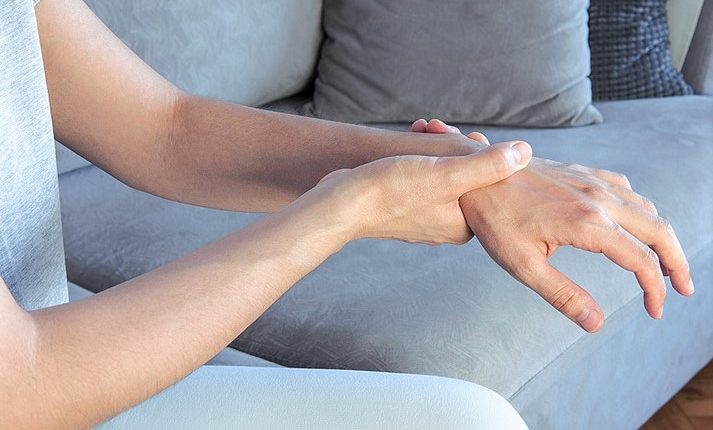
Carpal tunnel syndrome (CTS): Causes, Symptoms, Diagnosis And Treatment
Carpal tunnel syndrome (CTS) is pressure on a nerve in your wrist. It causes tingling, numbness and pain in your hand and fingers
Check if you have carpal tunnel syndrome (CTS)
The symptoms of carpal tunnel syndrome include:
- an ache or pain in your fingers, hand or arm
- numb hands
- tingling or pins and needles
- a weak thumb or difficulty gripping
These symptoms often start slowly and come and go.
They’re usually worse at night.
How to treat carpal tunnel syndrome (CTS) yourself
CTS sometimes gets better by itself in a few months, particularly if you have it because you’re pregnant.
Wear a wrist splint
A wrist splint is something you wear on your hand to keep your wrist straight.
It helps to relieve pressure on the nerve.
You wear it at night while you sleep.
You’ll have to wear a splint for at least 4 weeks before it starts to feel better.
You can buy wrist splints online or from pharmacies.
Stop or cut down on things that may be causing it
Stop or cut down on anything that causes you to frequently bend your wrist or grip hard, such as using vibrating tools for work or playing an instrument.
Painkillers
Painkillers like paracetamol or ibuprofen may help carpal tunnel pain short-term.
But there’s little evidence to say they can treat the cause of CTS, so it’s important not to rely on them.
Hand exercises
There’s a small amount of evidence to suggest hand exercises help ease the symptoms of CTS.
Treatment for carpal tunnel syndrome (CTS) from a GP
If a wrist splint does not help, the GP might recommend a steroid injection into your wrist.
This brings down swelling around the nerve, easing the symptoms of CTS.
Steroid injections are not always a cure. CTS can come back after a few months and you may need another injection.
Carpal tunnel syndrome surgery
If your CTS is getting worse and other treatments have not worked, the GP might refer you to a specialist to discuss surgery.
Surgery usually cures CTS. You and your specialist will decide together if it’s the right treatment for you.
An injection numbs your wrist so you do not feel pain (local anaesthetic) and a small cut is made in your hand.
The carpal tunnel inside your wrist is cut so it no longer puts pressure on the nerve.
The operation takes around 20 minutes and you do not have to stay in hospital overnight.
It can take a month after the operation to get back to normal activities.
What causes carpal tunnel syndrome (CTS)
CTS happens when the carpal tunnel inside your wrist swells and squeezes 1 of your nerves (median nerve).
You’re more at risk if you:
- are overweight
- are pregnant
- do work or hobbies that mean you repeatedly bend your wrist or grip hard, such as using vibrating tools
- have another illness, such as arthritis or diabetes
- have a parent, brother or sister with CTS
- have previously injured your wrist
Read Also
Emergency Live Even More…Live: Download The New Free App Of Your Newspaper For IOS And Android
Symptomatology And Therapy For Carpal Tunnel Syndrome
Fracture Of The Wrist: How To Recognise And Treat It
Fibromyalgia: The Importance Of A Diagnosis
Electromyography (EMG), What It Assesses And When It Is Done
Carpal Tunnel Syndrome: Diagnosis And Treatment
What Is Carpal Tunnel Syndrome? Causes, Symptoms And Treatment Of This Neurological Disorder
Hand And Wrist Sprains And Fractures: The Most Common Causes And What To Do
Wrist Fracture: Plaster Cast Or Surgery?
Wrist And Hand Cysts: What To Know And How To Treat Them
Exercise Addiction: Causes, Symptoms, Diagnosis And Treatment
Rotator Cuff Injury: What Does It Mean?
Tendon Injuries: What They Are And Why They Occur
Elbow Dislocation: Evaluation Of Different Degrees, Patient Treatment And Prevention
Cruciate Ligament: Watch Out For Ski Injuries
Sport And Muscle Injury Calf Injury Symptomatology
Meniscus, How Do You Deal With Meniscal Injuries?
Meniscus Injury: Symptoms, Treatment And Recovery Time
First Aid: Treatment For ACL (Anterior Cruciate Ligament) Tears
Anterior Cruciate Ligament Injury: Symptoms, Diagnosis And Treatment
Work-Related Musculoskeletal Disorders: We Can All Be Affected
Patellar Luxation: Causes, Symptoms, Diagnosis And Treatment
Arthrosis Of The Knee: An Overview Of Gonarthrosis
Varus Knee: What Is It And How Is It Treated?
Patellar Chondropathy: Definition, Symptoms, Causes, Diagnosis And Treatment Of Jumper’s Knee
Jumping Knee: Symptoms, Diagnosis And Treatment Of Patellar Tendinopathy
Symptoms And Causes Of Patella Chondropathy
Unicompartmental Prosthesis: The Answer To Gonarthrosis
Anterior Cruciate Ligament Injury: Symptoms, Diagnosis And Treatment
Ligaments Injuries: Symptoms, Diagnosis And Treatment
Knee Arthrosis (Gonarthrosis): The Various Types Of ‘Customised’ Prosthesis
Rotator Cuff Injuries: New Minimally Invasive Therapies
Knee Ligament Rupture: Symptoms And Causes
MOP Hip Implant: What Is It And What Are The Advantages Of Metal On Polyethylene
Hip Pain: Causes, Symptoms, Diagnosis, Complications, And Treatment
Hip Osteoarthritis: What Is Coxarthrosis
Why It Comes And How To Relieve Hip Pain
Hip Arthritis In The Young: Cartilage Degeneration Of The Coxofemoral Joint
Visualizing Pain: Injuries From Whiplash Made Visible With New Scanning Approach
Coxalgia: What Is It And What Is The Surgery To Resolve Hip Pain?
Lumbago: What It Is And How To Treat It
Lumbar Puncture: What Is A LP?
General Or Local A.? Discover The Different Types
Intubation Under A.: How Does It Work?
How Does Loco-Regional Anaesthesia Work?
Are Anaesthesiologists Fundamental For Air Ambulance Medicine?
Epidural For Pain Relief After Surgery
Lumbar Puncture: What Is A Spinal Tap?
Lumbar Puncture (Spinal Tap): What It Consists Of, What It Is Used For
What Is Lumbar Stenosis And How To Treat It
Lumbar Spinal Stenosis: Definition, Causes, Symptoms, Diagnosis And Treatment
Cruciate Ligament Injury Or Rupture: An Overview



